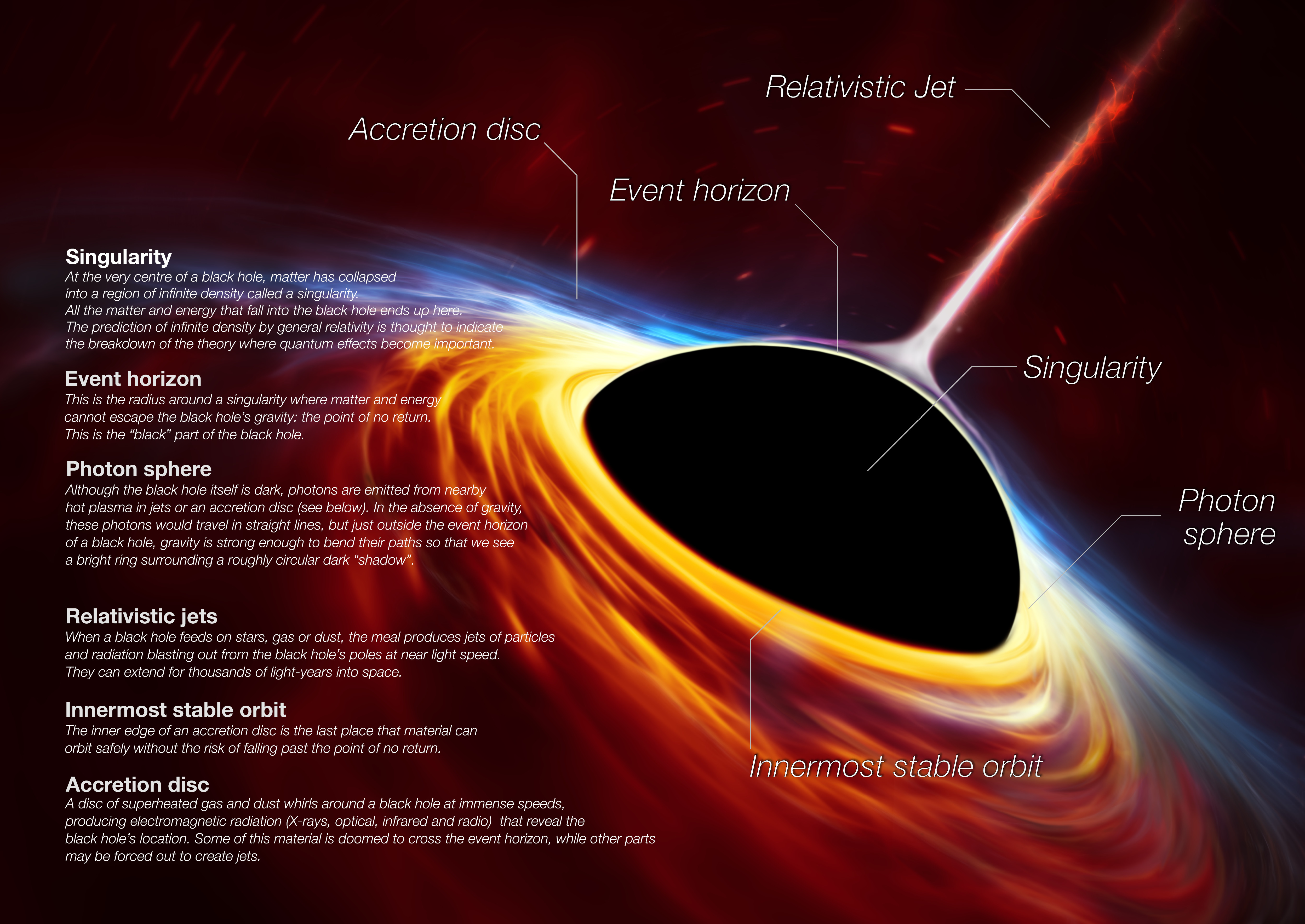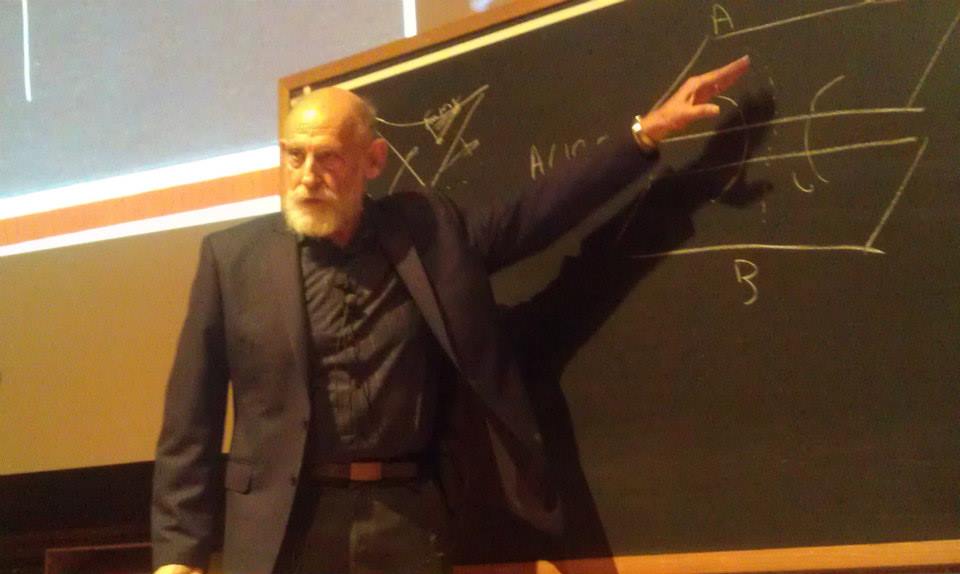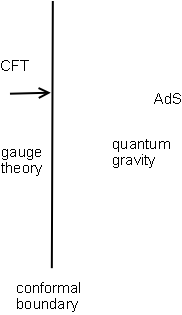|
Membrane Paradigm
In black hole theory, the black hole membrane paradigm is a simplified model, useful for visualising and calculating the effects predicted by quantum mechanics for the exterior physics of black holes, without using quantum-mechanical principles or calculations. It models a black hole as a thin, classically radiating surface (or membrane) at or vanishingly close to the black hole's event horizon. This approach to the theory of black holes was created by Kip S. Thorne, R. H. Price and D. A. Macdonald. Electrical resistance Thorne (1994) relates that this approach to studying black holes was prompted by the realisation by Hanni, Ruffini, Wald and Cohen in the early 1970s that since an electrically charged pellet dropped into a black hole should still ''appear'' to a distant outsider to be remaining just outside the event horizon, if its image persists, its electrical fieldlines ought to persist too, and ought to point to the location of the "frozen" image (1994, pp. 406). If ... [...More Info...] [...Related Items...] OR: [Wikipedia] [Google] [Baidu] |
Black Hole
A black hole is a massive, compact astronomical object so dense that its gravity prevents anything from escaping, even light. Albert Einstein's theory of general relativity predicts that a sufficiently compact mass will form a black hole. The boundary (topology), boundary of no escape is called the event horizon. A black hole has a great effect on the fate and circumstances of an object crossing it, but has no locally detectable features according to general relativity. In many ways, a black hole acts like an ideal black body, as it reflects no light. Quantum field theory in curved spacetime predicts that event horizons emit Hawking radiation, with thermal radiation, the same spectrum as a black body of a temperature inversely proportional to its mass. This temperature is of the Orders of magnitude (temperature), order of billionths of a kelvin for stellar black holes, making it essentially impossible to observe directly. Objects whose gravitational fields are too strong for ... [...More Info...] [...Related Items...] OR: [Wikipedia] [Google] [Baidu] |
Virtual Particle
A virtual particle is a theoretical transient particle that exhibits some of the characteristics of an ordinary particle, while having its existence limited by the uncertainty principle, which allows the virtual particles to spontaneously emerge from vacuum at short time and space ranges. The concept of virtual particles arises in the perturbation theory (quantum mechanics), perturbation theory of quantum field theory (QFT) where interactions between ordinary particles are described in terms of exchanges of virtual particles. A process involving virtual particles can be described by a schematic representation known as a Feynman diagram, in which virtual particles are represented by internal lines. Virtual particles do not necessarily carry the same mass as the corresponding ordinary particle, although they always conserve energy and momentum. The closer its characteristics come to those of ordinary particles, the longer the virtual particle exists. They are important in the ph ... [...More Info...] [...Related Items...] OR: [Wikipedia] [Google] [Baidu] |
Black Holes
A black hole is a massive, compact astronomical object so dense that its gravity prevents anything from escaping, even light. Albert Einstein's theory of general relativity predicts that a sufficiently compact mass will form a black hole. The boundary of no escape is called the event horizon. A black hole has a great effect on the fate and circumstances of an object crossing it, but has no locally detectable features according to general relativity. In many ways, a black hole acts like an ideal black body, as it reflects no light. Quantum field theory in curved spacetime predicts that event horizons emit Hawking radiation, with the same spectrum as a black body of a temperature inversely proportional to its mass. This temperature is of the order of billionths of a kelvin for stellar black holes, making it essentially impossible to observe directly. Objects whose gravitational fields are too strong for light to escape were first considered in the 18th century by John ... [...More Info...] [...Related Items...] OR: [Wikipedia] [Google] [Baidu] |
Leonard Susskind
Leonard Susskind (; born June 16, 1940)his 60th birth anniversary was celebrated with a special symposium at Stanford University.in Geoffrey West's introduction, he gives Suskind's current age as 74 and says his birthday was recent. is an American theoretical physicist, professor of theoretical physics at Stanford University and founding director of the Stanford Institute for Theoretical Physics. His research interests are string theory, quantum field theory, quantum statistical mechanics and quantum cosmology. He is a member of the US National Academy of Sciences, and the American Academy of Arts and Sciences, an associate member of the faculty of Canada's Perimeter Institute for Theoretical Physics, and a distinguished professor of the Korea Institute for Advanced Study. Susskind is widely regarded as one of the fathers of string theory. He was the first to give a precise string-theoretic interpretation of the holographic principle in 1995 and the first to introduce the i ... [...More Info...] [...Related Items...] OR: [Wikipedia] [Google] [Baidu] |
Black Hole Complementarity
Black hole complementarity is a conjectured solution to the black hole information paradox, proposed by Leonard Susskind, Lárus Thorlacius, John Uglum, and Gerard 't Hooft. Overview Ever since Stephen Hawking suggested information is lost in an evaporating black hole once it passes through the event horizon and is inevitably destroyed at the singularity, and that this can turn pure quantum states into mixed states, some physicists have wondered if a complete theory of quantum gravity might be able to conserve information with a unitary time evolution. But how can this be possible if information cannot escape the event horizon without traveling faster than light? This seems to rule out Hawking radiation as the carrier of the missing information. It also appears as if information cannot be "reflected" at the event horizon as there is nothing special about the horizon locally. Leonard Susskind, Lárus Thorlacius, and John Uglum proposed a radical resolution to this problem by c ... [...More Info...] [...Related Items...] OR: [Wikipedia] [Google] [Baidu] |
Holographic Principle
The holographic principle is a property of string theories and a supposed property of quantum gravity that states that the description of a volume of space can be thought of as encoded on a lower-dimensional boundary to the region – such as a light-like boundary like a gravitational horizon. First proposed by Gerard 't Hooft, it was given a precise string theoretic interpretation by Leonard Susskind, who combined his ideas with previous ones of 't Hooft and Charles Thorn. Susskind said, "The three-dimensional world of ordinary experience—the universe filled with galaxies, stars, planets, houses, boulders, and people—is a hologram, an image of reality coded on a distant two-dimensional surface." As pointed out by Raphael Bousso, Thorn observed in 1978 that string theory admits a lower-dimensional description in which gravity emerges from it in what would now be called a holographic way. The prime example of holography is the AdS/CFT correspondence. The holographic pr ... [...More Info...] [...Related Items...] OR: [Wikipedia] [Google] [Baidu] |
Kip S
Kip, KIP or kips may refer to: Athletics * Kip (artistic gymnastics), a basic skill on the women's uneven bars * Kip (trampolining), a coaching skill used in trampolining * Kip-up, an acrobatic manoeuvre used in martial arts and gymnastics People * Kip (given name), including a list of people and fictional characters with the name * Kip (nickname), including a list of people with the nickname * Kip (surname), including a list of people with the name * Billy Gunn (born 1963), ring name Kip, American wrestler Places * Kip, Croatia * Kip, Southern Highlands Province, Papua New Guinea * Kip Peak, Queen Alexandra Range, Antarctica * Kip Water, Inverclyde, Scotland Other uses * Kip (unit), a U.S. customary unit of force * Kham language, ISO 639 code kip * CIP/KIP, a family of mammalian cyclin dependent kinase inhibitors * Lao kip, the currency of Laos * Katathym-imaginative psychotherapy, or guided imagery, a mind-body intervention * Kinetic impact projectile, or bat ... [...More Info...] [...Related Items...] OR: [Wikipedia] [Google] [Baidu] |
Paradigm
In science and philosophy, a paradigm ( ) is a distinct set of concepts or thought patterns, including theories, research methods, postulates, and standards for what constitute legitimate contributions to a field. The word ''paradigm'' is Ancient Greek, Greek in origin, meaning "pattern". Etymology ''Paradigm'' comes from Greek παράδειγμα (''paradeigma''); "pattern, example, sample"; from the verb παραδείκνυμι (''paradeiknumi''); "exhibit, represent, expose"; and that from παρά (''para''); "beside, beyond"; and δείκνυμι (''deiknumi''); "to show, to point out". In classical (Greek-based) rhetoric, a paradeigma aims to provide an audience with an illustration of a similar occurrence. This illustration is not meant to take the audience to a conclusion; however, it is used to help guide them to get there. One way of how a ''paradeigma'' is meant to guide an audience would be exemplified by the role of a personal accountant. It is not the job of a p ... [...More Info...] [...Related Items...] OR: [Wikipedia] [Google] [Baidu] |
Pair Production
Pair production is the creation of a subatomic particle and its antiparticle from a neutral boson. Examples include creating an electron and a positron, a muon and an antimuon, or a proton and an antiproton. Pair production often refers specifically to a photon creating an electron–positron pair near a nucleus. As energy must be conserved, for pair production to occur, the incoming energy of the photon must be above a threshold of at least the total rest mass energy of the two particles created. (As the electron is the lightest, hence, lowest mass/energy, elementary particle, it requires the least energetic photons of all possible pair-production processes.) Conservation of energy and momentum are the principal constraints on the process. All other conserved quantum numbers ( angular momentum, electric charge, lepton number) of the produced particles must sum to zero thus the created particles shall have opposite values of each other. For instance, if one partic ... [...More Info...] [...Related Items...] OR: [Wikipedia] [Google] [Baidu] |
Quantum Mechanics
Quantum mechanics is the fundamental physical Scientific theory, theory that describes the behavior of matter and of light; its unusual characteristics typically occur at and below the scale of atoms. Reprinted, Addison-Wesley, 1989, It is the foundation of all quantum physics, which includes quantum chemistry, quantum field theory, quantum technology, and quantum information science. Quantum mechanics can describe many systems that classical physics cannot. Classical physics can describe many aspects of nature at an ordinary (macroscopic and Microscopic scale, (optical) microscopic) scale, but is not sufficient for describing them at very small submicroscopic (atomic and subatomic) scales. Classical mechanics can be derived from quantum mechanics as an approximation that is valid at ordinary scales. Quantum systems have Bound state, bound states that are Quantization (physics), quantized to Discrete mathematics, discrete values of energy, momentum, angular momentum, and ot ... [...More Info...] [...Related Items...] OR: [Wikipedia] [Google] [Baidu] |
Hawking Radiation
Hawking radiation is black-body radiation released outside a black hole's event horizon due to quantum effects according to a model developed by Stephen Hawking in 1974. The radiation was not predicted by previous models which assumed that once electromagnetic radiation is inside the event horizon, it cannot escape. Hawking radiation is predicted to be extremely faint and is many orders of magnitude below the current best telescopes' detecting ability. Hawking radiation would reduce the mass and rotational energy of black holes and consequently cause black hole evaporation. Because of this, black holes that do not gain mass through other means are expected to shrink and ultimately vanish. For all except the smallest black holes, this happens extremely slowly. The radiation temperature, called Hawking temperature, is inversely proportional to the black hole's mass, so micro black holes are predicted to be larger emitters of radiation than larger black holes and should dissipat ... [...More Info...] [...Related Items...] OR: [Wikipedia] [Google] [Baidu] |






